6 Common Pool Pests that Prevent You From Having Fun in the Sun
6 Common Pool Pests that Prevent You From Having Fun in the Sun
With the weather consistently heating up, swimming pools across America are finally being put to use again (unless you’re one of those lucky pool owners with a heated pool). There is nothing better on a hot day than relaxing in a pool and feeling the warm sun balance with the cool water on your skin. But just like any other warm-weather outdoor activity, hanging out in the pool is rarely completed without the appearance of pests. In addition to the innocent bee or butterfly that may accidentally fall into the water, there is a myriad of pests that specifically love the water – or, at least, the vegetation and insect life around the pool. Let’s look at some of the most common water pests and how they enjoy our pools without an invitation.
Water Boatmen
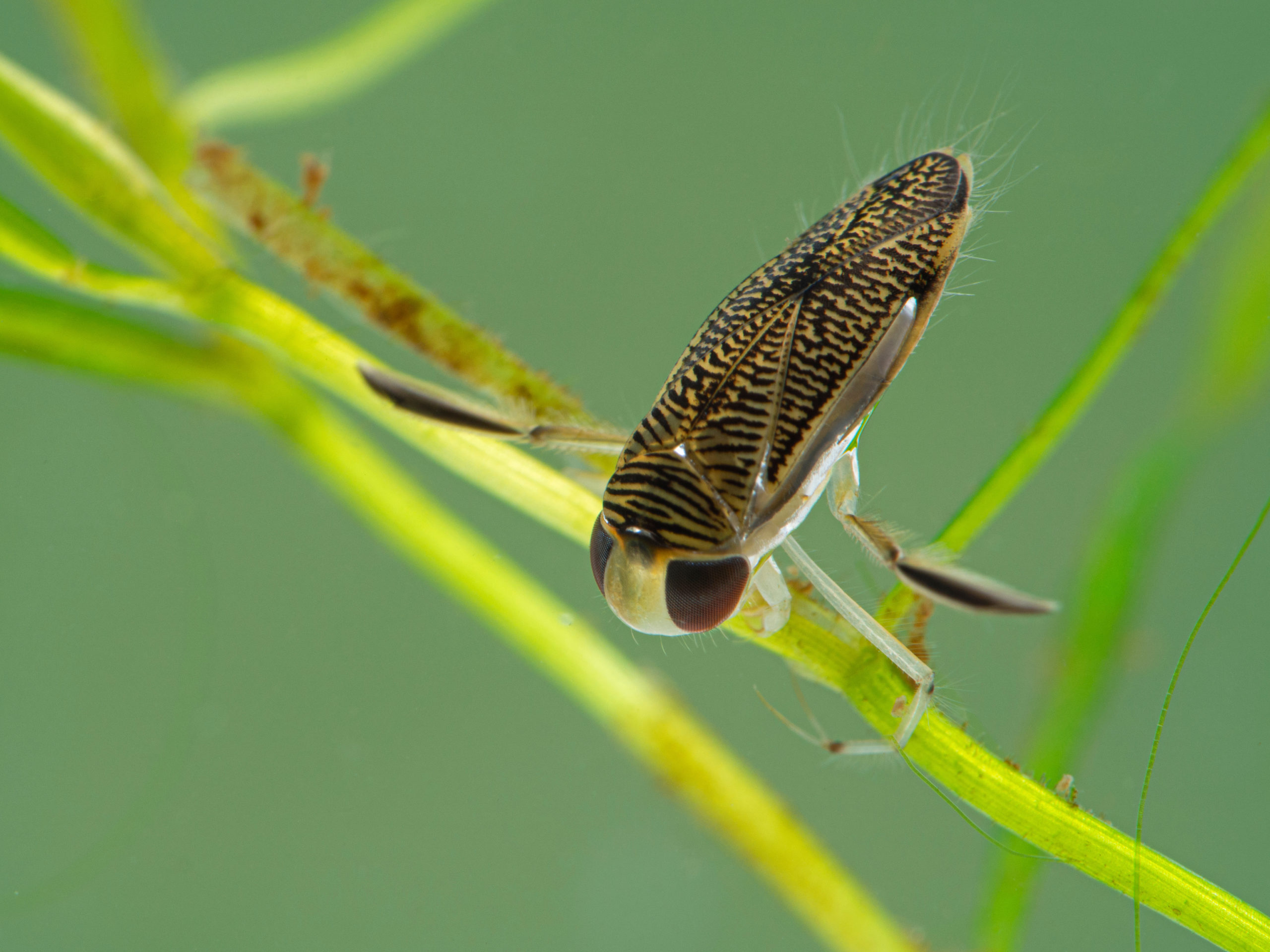
These insects are a lot scarier in appearance than they are in personality. Water boatmen, also called corixids, are more concerned with finding something to eat than with the humans in the pool. These large insects can fly, which is how they get into our pools in the first place. They use their longer two back legs to glide through the water, and can even go to the bottom of the pool for a while. Their main motivation for being in our pools is for their favorite food: algae. While untouched pools can grow an impressive amount of algae, even frequently cleaned pools can begin to sprout unseen algae spores if the chemicals and water aren’t maintained often enough. Water boatmen can see small algae spots that even we can’t, so they will often come into the pool and eat “invisible” algae to their hearts content. They also enjoy insect larvae and plant matter, but algae seems to be their favorite.
In addition to eating algae, water boatman also lay their eggs in algae. This is so that the hatched larvae immediately has a food source to build up their strength. They only live in stagnant water because moving water is too powerful for them to stay attached in. Pools, lakes, and ponds are the frequent homes of these pests. Water boatmen are also attracted to artificial light, so most built-in pool lights will draw them in at night. We will talk about general prevention methods later, but a good fact to remember is that a clean pool is often a pest-free pool. Insects can fall in all the time, but frequent sweeping and cleaning will prevent them from making their underwater homes in your pool.
Back Swimmers
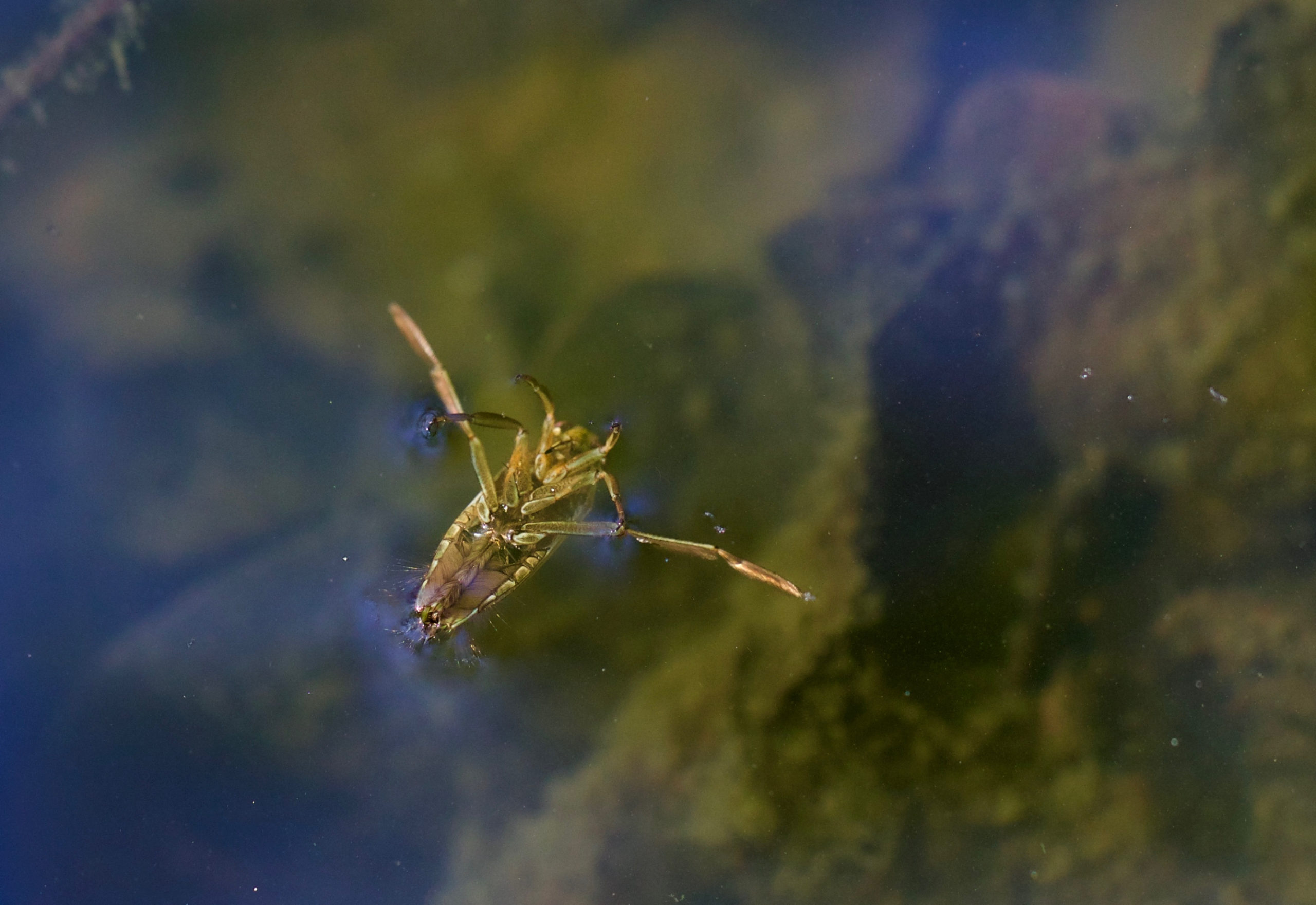
Upon first glance, back swimmers can be easily mistaken for water boatmen in the water. They are both large insects that can swim with ease, and actually want to be in the pool. But back swimmers are more carnivorous and hunter-esque than the previous pest. Back swimmers eat all kinds of insects, including water boatmen and water beetles, and use all of their sets of legs in different ways to consume their prey. Their front set is for piercing the prey when they are in range, the middle set is for grasping the captured prey, and the back longer set is for swimming through the water as they search for a hiding spot.
Similar to water boatmen, they also lay their eggs in algae for the same reason of providing for their hatchlings. This seems to be the only time of their life that they seek out algae, since they eat other insects the rest of the time. Back swimmers are naturally aggressive, and will not hesitate to bite anyone that gets close enough to them. They don’t care that this is your pool; back swimmers will treat it like their own and deliver a stinging bite to anyone nearby. They aren’t venomous, but it is still important to treat the bite just like any other insect bite. If it isn’t healed after a week or so, or if it seems to be infected, please seek medical attention immediately.
What’s the Difference?
After looking at the core facts of these two pests, it seems like we just described the same insect twice. Water boatmen and back swimmers do share an absurd amount of similarities. However, there are a few key variations that can mean the difference between a harmless pest and a territorial attacker. The most obvious difference is in how they swim. Water boatmen will go to the bottom of the pool in search of algae. They use an air bubble of oxygen to help them stay submerged for longer, then come up for air when they run out. Their long back legs help them glide through the water at any depth. Conversely, back swimmers swim – you guessed it – on their backs on top of the water! They look like they are swimming upside down when you compare them to other aquatic pests.
Another visual difference is how they look. Water boatmen are oval with brown to greenish-brown colorings, while back swimmers are brown with an array of colors near their head. They can have green, yellow, and red markings. The third major difference between the two is in their temperament. Water boatmen won’t come near us on purpose, and they only bite if they are cornered or touched. Back swimmers are definitely the more aggressive of the two, and can make swimming an unpleasant experience very quickly. They are territorial and treat the water like their own when we have the audacity to get in our own pool. Their bite is not poisonous, but the pain level is likened to the horsefly’s or to a bee sting, which is a pretty painful experience. Water boatmen and back swimmers have their differences, but a good rule of thumb is to get these pests out with a sweep or skimmer instead of your bare hands, just to avoid any unnecessary bites.
Mosquitoes
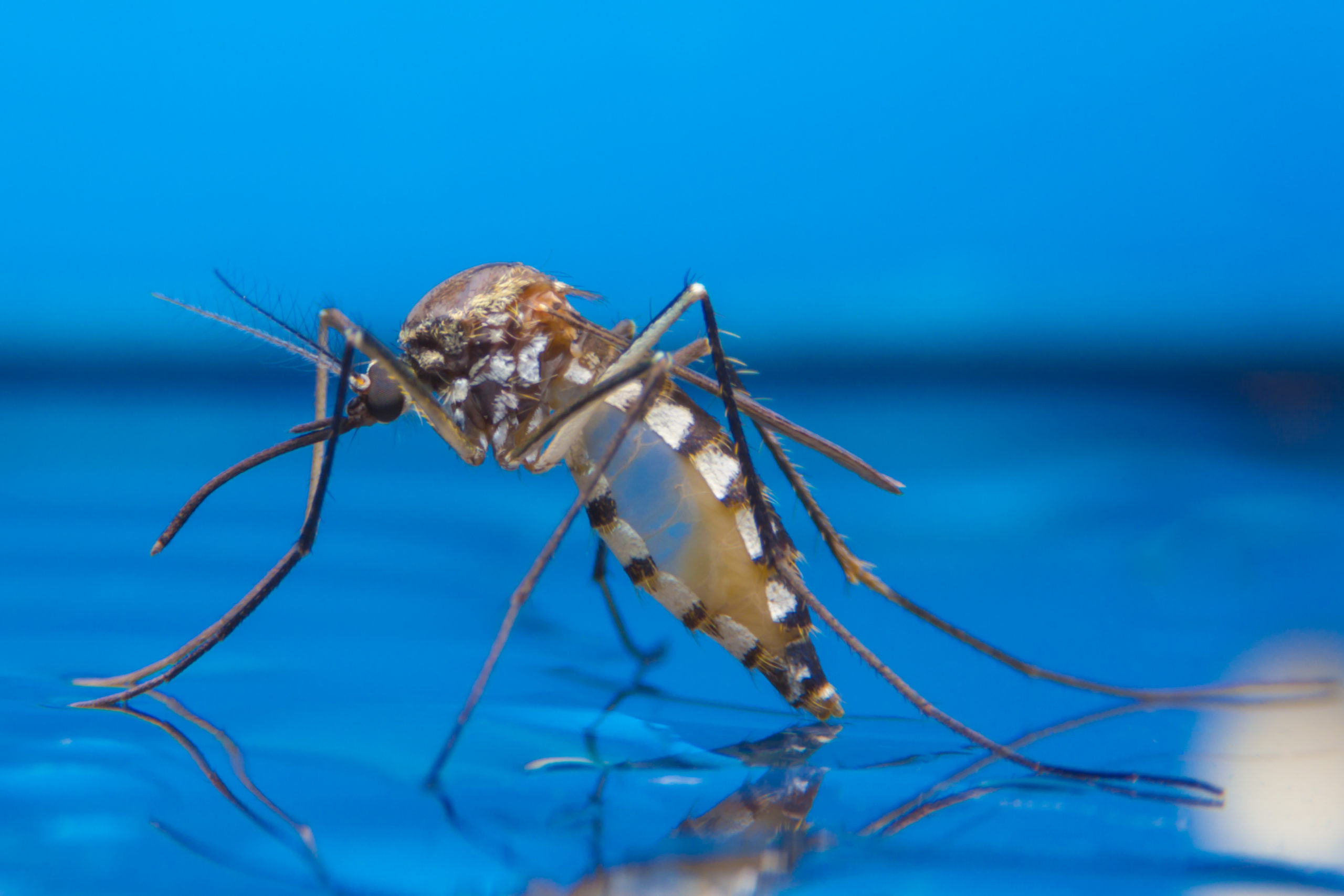
There’s nothing like enjoying the relaxing ambience of your pool and backyard during the day, and coming inside later to find a slew of mosquito bites that popped up within the last 6 hours. Yes, unfortunately, mosquitoes love your pool too. Clean pools with frequently-checked chemicals won’t see nearly as many mosquitoes. They favor dirty and calm pools, since they are less likely to be disturbed. This is because mosquitoes lay their eggs in still water, especially in fresh water, so they need calm waters for the eggs to survive. Most of the mosquito’s life stages are actually completed in the water, believe it or not. Their whole life before being a full adult is spent in the water, since they can live off of plant and organic debris.
There are more downsides to having mosquitoes around than just the bites that they inflict on us. The eggs can survive in the water for months as they wait until they naturally feel it is safe enough to hatch. So even if it doesn’t look like you have mosquitoes now, it doesn’t mean you will always have a mosquito-free yard. Also, mosquitoes are a favorite food of many larger creatures. These include dragonflies, frogs, birds, and bats. So an abundance of mosquitoes means that you will likely start seeing a wild kingdom in your yard! This is why it’s so beneficial to get rid of mosquitoes as soon as you see them; it will prevent other pests and critters from making your pool and yard their own home too.
Springtails

We have come to the first pest that is found in our pools because they fell in, not because they are diving in to find food. Springtails get around mainly by jumping, and sometimes they can overshoot their target. But since they do want to be in moisture, it’s not the worst thing in the world for them to be in a pool. The preferred environment of springtails is anything that is damp, decomposing, and organic. They are found around our pools because of the landscaping and plants around it, as well as the humidity in the air. They feed upon these plants, so they will stay in the area as long as they are consistently fed. Springtails travel in groups and are very docile in nature. They still stay in their groups after falling in the pool, so you will know if they are in the water by the sight of an insect clump on the surface (gross!).
The easiest way to prevent springtails is by removing any decaying plant matter around the pool. This is their main food source and habitat, so they won’t have any reason to stick around if it’s gone. Also, springtails can stick to the sides of the pool and remain there as long as the waters are calm. They can’t live underwater, but their waterproof covering keeps them from immediately drowning on the surface. Shocking the pool and maintaining the proper chlorine level will kill any springtails touching the water.
Water Striders
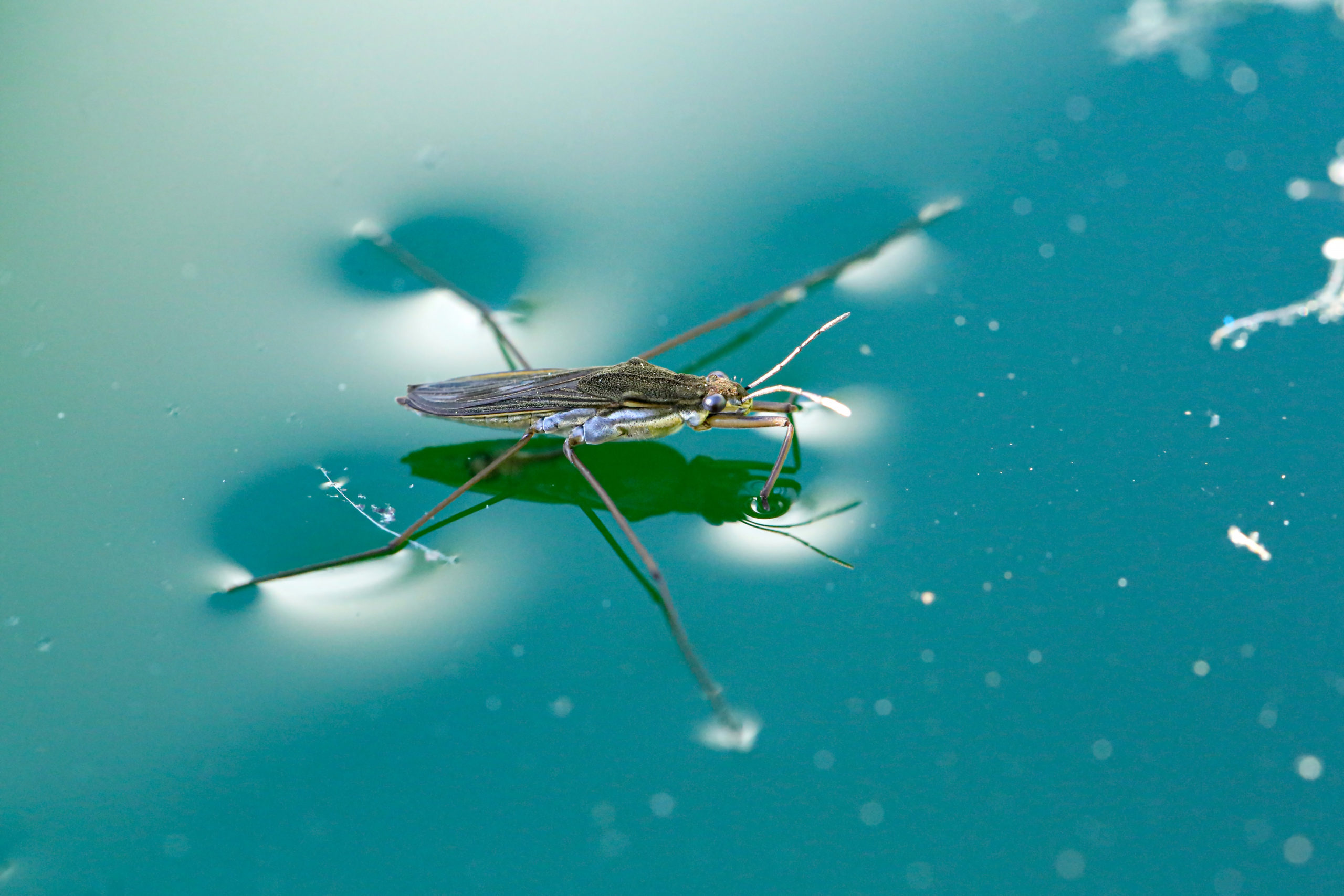
These may be the most frequent pool visitors out of the list of aquatic pests. They are dark, smaller insects with very long legs, giving them an almost spider-like appearance. They are almost always seen gliding effortlessly across the water’s surface, and actually appear to be walking on the water! The truth behind it is slightly less cool than this possibility. Water striders use a membrane on top of the water to travel through, and their spindly legs allow them to steer and accelerate as they choose. Fortunately, they don’t bite and actually don’t want anything to do with us.
Water striders eat tiny insects found in the pool, so they are actually helpful as a natural pest control. They are also a sign that smaller pests are living in the pool, since they won’t go for a swim without a reliable food source around. Their presence doesn’t mean that your pool is dirty, since water striders can live in a wide range of water types. But if you don’t want them in your pool, they can be easily scooped up with a skimmer and taken out.
Thrips
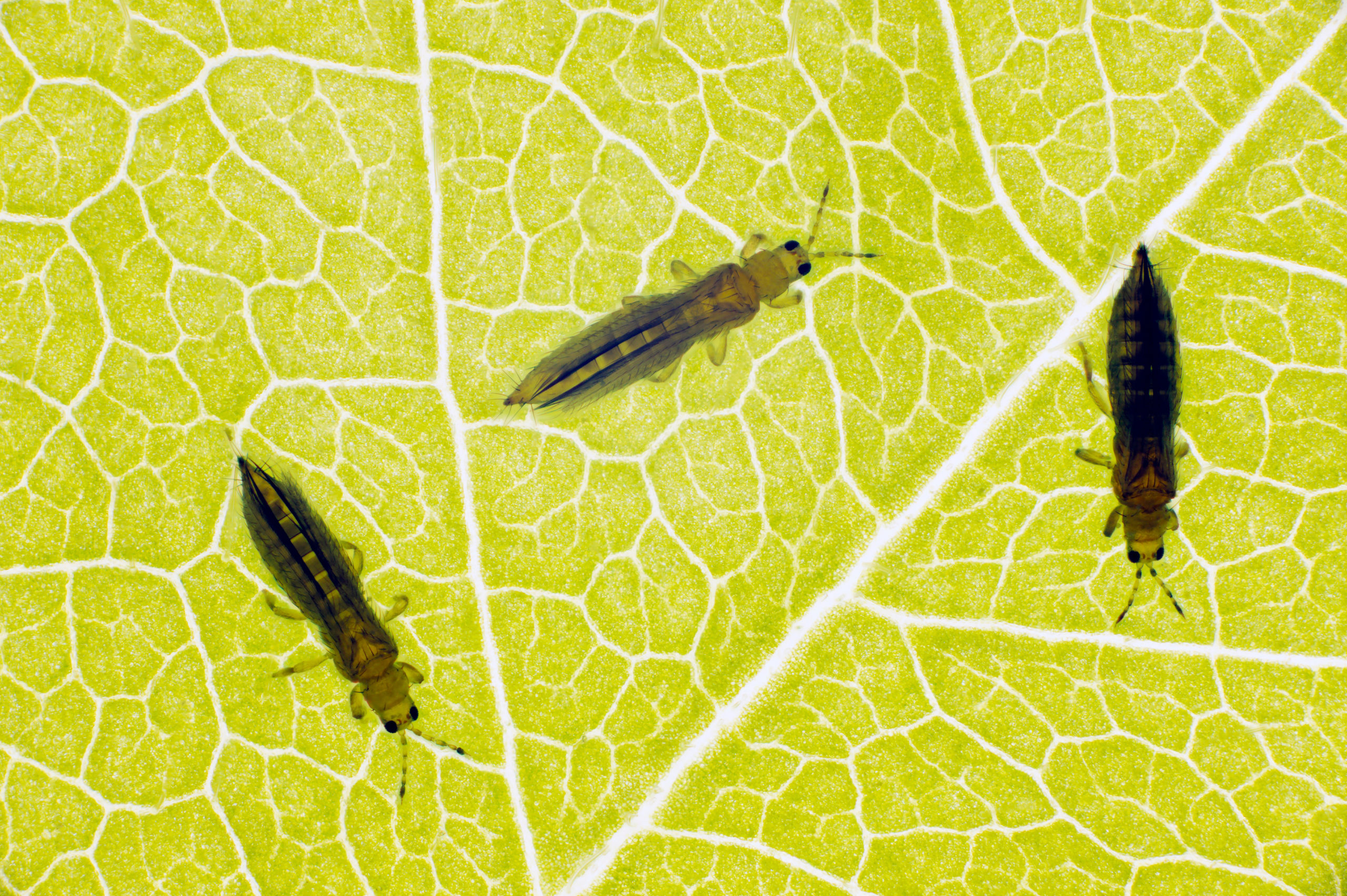
These insects seem like the closest one can get to being invisible without technically being invisible. They are 1/20th of an inch, which means that we can barely see them without a magnifying glass. Thrips are herbivores, so they only eat plants and love the vegetation around a pool. You may find some little black dots on your arms or legs when you get out of the pool, leaving you to wonder what in the world is in the water. These dots are likely thrips, who got a little too curious for their own good. Thrips don’t actively seek out humans to bite, but they can bite if they find themselves on you. This is simply because they are trying to figure out if you are a plant! The bites will just feel like a tiny pinch and don’t contain any poison.
Thrips are also attracted to light, so lights on in the pool or in the house will draw them to the area. To prevent thrips from falling in the pool, as with most pests, keep the landscaping trimmed back. This way, when the thrips go to enjoy their green meals, they will be far away from the dangerous waters of the pool. If you do happen to find a lot of thrips in your pool, you could easily scoop them out or vacuum them up. They are harmless, but can be annoying when there is a lot of them. If you do find any thrips in the home, they can be easily taken care of due to their small size and easygoing nature. A thorough vacuuming or sweeping will get rid of the thrips and leave you with a home free of those crawling black dots.
Prevention and Removal

Now that we know about all of these water pests, it would help to talk about how to prevent them from returning or making their initial appearance. The best, and most succinct, way is to keep up with general pool maintenance. You may have a specialist who comes out weekly to do a deeper inspection of the equipment and chemicals, but cleaning in between those services is also important. Use the skimmer to get any leaves or dead insects floating on top, as those are major draws for some pests. Running the pump and the pool sweep, if you have one, is also very helpful in keeping the water clean and pest-free. If you have vegetation or trees near the pool, keep them trimmed back. The pests who go to these plants for food may find their way into the pool and make a headache for you later.
Of course, pest control services is always a valid option for maintaining a low level of pests in your yard, especially this time of year. Our team is happy to tackle pest problems that are keeping you from enjoying your swimming pool and the beautiful weather. Contact us at any time to learn more about our EPA-approved treatments and how we can remove the pests who are treating your own pool like a public pool just for their leisure.
Citations
10 types of swimming pool bugs and how to get rid of them. (n.d.). How to Murder Pests. Retrieved May 12, 2022, from https://howtomurderpests.com/types-of-swimming-pool-bugs/
Common swimming pool bugs. (2019, August 26). Aptive. Retrieved May 12, 2022, from https://www.goaptive.com/blog/home-garden-pests/swimming-pool-bugs
Giovanisci, M. (2021, July 27). How to keep mosquitoes away from your pool. Swim University. Available at https://www.swimuniversity.com/pool-mosquitoes/ (Accessed on May 12, 2022).
How to get rid of water bugs. (n.d.). Intec-america. Retrieved May 12, 2022, from https://www.intec-america.com/blog/how-to-get-rid-of-water-bugs/
Meyers, A. (2021, July 21). Springtails in pool causes and solutions. Pest Week. Available at https://pestweek.com/springtails-in-pool/ (Accessed on May 13, 2022).
Water bugs in your pool. (n.d.). Rode Pool Services. Retrieved May 12, 2022, from https://www.rodepools.com.au/articles/water-bugs-in-your-pool
Request a Free Quote Today
(We do not share your data with anybody, and only use it for its intended purpose)


